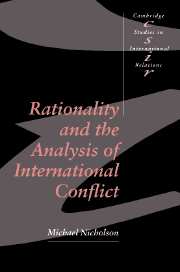Book contents
- Frontmatter
- Contents
- Preface
- Introduction: Rationality and the analysis of conflict
- PART I CONFLICT
- PART II RATIONAL BEHAVIOUR
- 3 RATIONALITY AND CONFLICT
- 4 CONFLICT AND THE PARADOXES OF RATIONALITY
- 5 THE ZERO-SUM GAME: SOLUTIONS AND INTERPRETATIONS
- 6 EMOTION AND RATIONALITY
- 7 INTERNATIONAL CRISES: THE WARPING OF RATIONALITY
- RATIONAL BEHAVIOUR AND RATIONAL CHOICE: AN ASSESSMENT
- PART III RATIONAL BELIEF: SOME TOPICS IN CONFLICT ANALYSIS
- PART IV CONCLUSION
- References
- Index
- Titles in the series
5 - THE ZERO-SUM GAME: SOLUTIONS AND INTERPRETATIONS
Published online by Cambridge University Press: 24 November 2009
- Frontmatter
- Contents
- Preface
- Introduction: Rationality and the analysis of conflict
- PART I CONFLICT
- PART II RATIONAL BEHAVIOUR
- 3 RATIONALITY AND CONFLICT
- 4 CONFLICT AND THE PARADOXES OF RATIONALITY
- 5 THE ZERO-SUM GAME: SOLUTIONS AND INTERPRETATIONS
- 6 EMOTION AND RATIONALITY
- 7 INTERNATIONAL CRISES: THE WARPING OF RATIONALITY
- RATIONAL BEHAVIOUR AND RATIONAL CHOICE: AN ASSESSMENT
- PART III RATIONAL BELIEF: SOME TOPICS IN CONFLICT ANALYSIS
- PART IV CONCLUSION
- References
- Index
- Titles in the series
Summary
THE SOLUTION OF THE ZERO-SUM GAME
The zero-sum game is the case of pure conflict where interests are totally opposed. Such purity, even such a sinister purity, is a rarity in social life, but it is useful as a basis against which concepts of conflict can be compared.
A game such as the one-shot prisoners' dilemma (a non-zero-sum game) has a solution in the sense that there is a pair of strategies resulting in specified pay-offs which cannot be improved upon by either acting alone. We might feel uneasy with such a solution, as it is manifestly inefficient for the two players, but it seems a likely consequence if two people are caught in such a trap. There is more hope, however, in both the limited-play case of prisoners' dilemma and the supergame version. The one-shot game of chicken has two solutions, so at least in the symmetric case there is nothing to choose between them. Indeed if both actors pursue their favoured position, the end point may favour neither of them. In the limited-game version of chicken the situation is wholly ambiguous in the sense that no set of rules which can be plausibly interpreted as rational gives an unambiguous solution point. Indeed with non-zero-sum games we are often presented with situations where there is either no solution or several solutions.
- Type
- Chapter
- Information
- Rationality and the Analysis of International Conflict , pp. 89 - 103Publisher: Cambridge University PressPrint publication year: 1992



